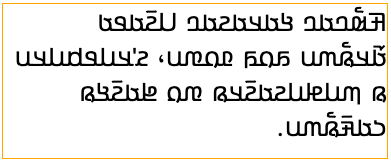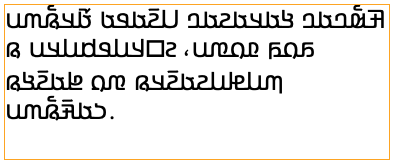If this script runs right-to-left, are there any issues when handling that? Is bidirectional text adequately supported? What about numbers and expressions? Do the Unicode bidi controls and HTML markup provide the support needed? Is isolation of directional runs problematic? See available information or check for currently needed data.
GitHub issue #23
This issue is applicable to all languages with RTL orthographies.
Style sheets need to add special rules for RTL styles if they are not supported by logical properties or values.
One approach is to create a second style sheet which, when pulled into an HTML page, overrides styles in the main style sheet with settings for RTL text. This approach is not ideal because it requires maintaining the styles in two separate locations, which can therefore get out of synch, and it requires explicit addition of a call to the second style sheet in every page that will support RTL text.
The :dir() pseudo-class avoids these issues by allowing the content author to include the RTL variations in the same style sheet as the others. However, it is not yet supported by all major browser engines.
For more details, see this GitHub issue, which is being used to track this gap. Please add any discussion there, and not to this issue.
GitHub issue #16
This issue is common to all RTL scripts.
When strings are passed around, some applications don't receive or use information about the appropriate base direction to use for those strings when they are rendered as part of a page.
This can lead to text being incorrectly aligned, and to text within a sentence or paragraph being incorrectly ordered. Some of this can be addressed by using heuristics to detect the direction first-strongly directional character in the string, but some strings can fail such heuristics.
HTML's dirname attribute, which is supposed to pass information with form data about direction of the text isn't fully interoperable across major browser engines.
This gap is now fixed. For details, see this GitHub issue.
GitHub issue #13
Adlam text displayed in a block element with dir set to auto should be automatically right-aligned, unless the base direction is set to LTR, like this:

In WebKit the text appears as follows:
This is a serious issue, and indicates that first-strong heuristics are not being applied. Note that this was not an issue for N'Ko, Arabic, Hebrew, Thaana, or Syriac text.
Interactive test, Text in languages that use RTL scripts will be automatically aligned with the right side of their container when dir is set to auto- Gecko: ✅ *Browser: Mozilla/5.0 (Macintosh; Intel Mac OS X 10.15; rv:96.0) Gecko/20100101 Firefox/96.0*
- Blink: ✅ *Browser: Mozilla/5.0 (Macintosh; Intel Mac OS X 10_15_7) AppleWebKit/537.36 (KHTML, like Gecko) Chrome/97.0.4692.71 Safari/537.36*
- Webkit: ✅ Adlam used to be broken, but is now fixed (see the bug report). *Browser: Mozilla/5.0 (Macintosh; Intel Mac OS X 10_15_7) AppleWebKit/605.1.15 (KHTML, like Gecko) Version/15.2 Safari/605.1.15*
WebkitThis was fixed in WebKit, so it now works as expected for all 3 major browser engines.
Priority initially set to basic because this was a serious issue for Adlam users, but now set to OK.
GitHub issue #10
This issue is common to all RTL scripts.
For support of bidirectional text in plain text, the Unicode Standard provides a number of formatting characters, which include RLI, LRI, PDI and FSI. See an explanation of how these work.
Note that the Unicode Standard recommends the use of RLI/LRI...PDI rather than the former RLE/LRE...PDF, because the newer code points directionally isolate the text they surround from that around it. This is important for producing bidirectional text.
Although markup should be used most of the time in HTML pages, there are parts of an HTML document that don't support markup, such as the title element and title, alt, and other attributes. These characters can be necessary for managing inline runs of such text.
The RLI, LRI, FSI, PDI characters still don't produce the necessary behaviour in all major web browser engines.Gecko and Blink support these characters. Webkit doesn't.
This is an issue related to Unicode support, rather than W3C specs.html mentions that text content may contain these characters.
i18n test suite, Isolating formatting characters
Webkit (2014)
WebKit now supports the required behaviour for these formatting characters. This means that they can be used interoperably on all major web browsers.These characters control fundamental behaviours for support of RTL scripts so priority is set as Basic.
GitHub issue #8
This issue is common to all RTL scripts.
Adoption of logical keywords such as -start and -end, rather than -left and -right needs to be completed.
For margins, padding, block size, border colour, width & style, logical keywords such as margin-inline-start or margin-block-end are widely supported by major browsers in their simplest forms (such as those just mentioned). However, logical properties are not well supported in shorthands such as margin-block or margin-inline or the margin property. The lack of support for shorthands is significant, since they are expected to have high use.
For more details, see this GitHub issue, which is being used to track this gap. Please add any discussion there, and not to this issue.









